Best CPUs for Workstations: June 2021
by Dr. Ian Cutress on June 10, 2021 12:15 PM EST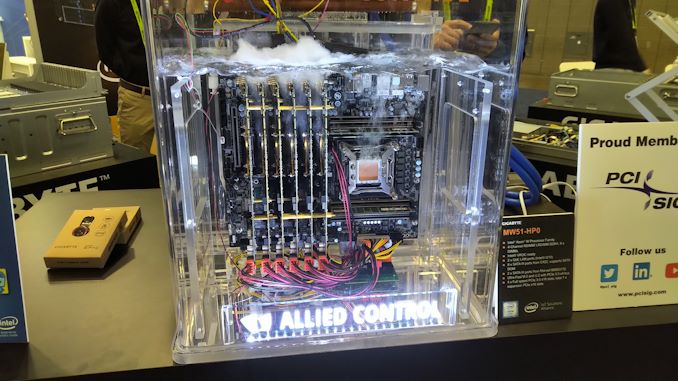
In our series of Best CPU guides, here’s the latest update to our recommended workstation CPUs list. All numbers in the text are updated to reflect pricing at the time of writing. Numbers in graphs reflect MSRP.
Best CPUs for Workstations June 2021
Sometimes choosing a CPU is hard. So we've got you covered. In our CPU Guides, we give you our pick of some of the best processors available, supplying data from our reviews. Our Best CPUs for Workstations guide mostly covers workstation processors available to consumers, although some server products cover both segments.
| Workstation CPU Recommendations: 2021 June (Prices are 10-June or MSRP) |
||||
| Segment | Processor | |||
| Most Cores | AMD Threadripper 3990X | $4796 | ||
| AMD EPYC 7702P | $4722 | |||
| AMD TR Pro 3995WX | $5487 | |||
| The Smart Money | AMD Threadripper 3970X | $2096 | ||
| HEDT Mid Range | AMD Threadripper 3960X | $1400 | ||
| AMD TR Pro 3955WX | $1149 | |||
| Intel Core i9-10980XE | $989 | |||
| AVX512 Accelerated | 2P: Intel Xeon Gold 6258R | $4020 | ||
| 1P: Intel Xeon W-3175X | $3105 | |||
| HEDT On a Budget | AMD Threadripper 1900X | $204 | ||
It’s been a while since we updated this guide, perhaps because the world of the workstation processor you can buy on the shelf hasn’t really changed all that much. While AMD is releasing new hardware, and differentiating between the high-end desktop with Threadripper and workstation with Threadripper Pro, Intel by contrast released its latest retail HEDT/WS processors back in November 2019, and hasn’t been in a position to update them since. Beyond, all signs coming out of Intel on their HEDT/WS retail platform indicate that it is a market they do not have the products for. Instead Intel is focusing on its more enterprise Xeon WS solutions, which only really come as part of a pre-built system.
Nonetheless the impact of the semiconductor shortage is affecting what people can buy. Some processors are fluctuating in and out of stock, and given that HEDT/WS processors give the most margin, there is some impetus from the manufacturers to provide sufficient stock where the demand is. Earlier this year AMD launched its Zen 2-based Threadripper Pro platform, providing the equivalent of an effective EPYC processor for single socket workstations only, but at higher frequencies. These processors have proven to be interesting, and we’re hands deep in our testing for review right now.
| Intel vs AMD Comparison | ||||
| AnandTech | Intel HEDT |
Intel Workstation |
AMD Threadripper |
AMD TR Pro |
| Generation | Cascade-X | Cascade-X | Zen 2 | Zen 2 |
| Marketing Name | Core 10th Gen | Xeon W-3200 | Threadripper 3000X | TR Pro 3900WX |
| Top SKU | i9-10980XE | W-3275 | TR3 3990X | TR Pro 3995WX |
| Release Date | 11/2019 | 6/2019 | 11/2019 | 8/2020 |
| Cores | 10-18 | 28 | 64 | 64 |
| TDP | 165 W | 205 W | 280 W | 280 W |
| Peak Power (as tested) |
190 W | - | 281 W | 279 W |
| Base Freq | 3000 MHz | 2500 MHz | 3800 MHz | 2900 MHz |
| Turbo Freq | 4800 MHz | 4400 MHz | 4500 MHz | 4300 <Jz |
| PCIe | 3.0 x48 | 3.0 x64 | 4.0 x56 | 4.0 x128 |
| Motherboards | X299 | LGA3647 | TRX40 | WRX80 |
| Price (tray/SEP) | $979 (1ku) | $4449 (1ku) | $3990 (SEP) | $5490 |
| Retail Today | $979 | N/A | $4796 | $5487 |
| 1ku = 1000 unit batch, 1 unit at retail is often slightly (3-5%) higher SEP = Suggested Etail Price |
||||
Threadripper Pro brings an interesting conundrum for users in this space: it’s more expensive than Threadripper, but offers 8-channel memory support and a full 128 PCIe 4.0 lanes. Depending on the price differential at any particular point in time, the TR Pro offering might be preferred regardless of workload. Right now, in June, we might be in this situation. For users waiting for Zen 3 based Threadripper, there’s still no ETA.
Going for the Most Cores:
AMD Threadripper 3990X (64c) at $4796 (up from $3848)
AMD EPYC 7702P (64c) at $4722
AMD Threadripper Pro 3995WX (64c) at $5487
Sometimes all you want are cores - either for masses of virtual machines, or highly parallel workloads, or something else. Both AMD and Intel try to keep their highest core count hardware for their enterprise lines, such as 64-core EPYCs and 28/56-core Xeons, which means that these also come at an additional cost for features such as multi-socket capabilities or RDIMM support and RAS features.
For more ‘consumer’ hardware, the highest core count on offer is 64 cores from AMD, with the Threadripper 3990X, currently available for $4796 which is well above its MSRP of $3990 (and up from $3848 since our last guide). This chip gives 56 lanes of PCIe 4.0, with another 8 lanes for the chipset, and comes in at a base frequency of 2.9 GHz and turbo of 4.3 GHz. We tested the Threadripper 3990X against $20k of Intel’s premium enterprise CPUs, and for workloads that were embarrassingly parallel.
You can read our full review of the 3990X here:
The 64 Core Threadripper 3990X CPU Review
In The Midst Of Chaos, AMD Seeks Opportunity
If there is a need for ECC (as TR support is board dependent), users can get 64 cores in this way if they want to go to EPYC or Threadripper Pro, depending on how much core performance is needed.
The single socket 64-core EPYC 7702P is the cheaper option choice here, with an MSRP of $4425, or a recent retail price of $4722. For that price the hardware has a base frequency of 2.0 GHz and a turbo frequency of 3.35 GHz, and access to eight full memory channels as well as 128 PCIe 4.0 lanes.
The Threadripper Pro 3995WX has higher frequencies due to its higher TDP (200W vs. 280W): 2.7 GHz base and 4.2 GHz turbo. It also has eight memory channels and 128 PCIe 4.0 lanes, the same as the EPYC, but it also costs more at $5487. The Threadripper Pro 3995WX is more widely available at retail, but users only have three motherboards to choose from.
All the AMD options here are Zen 2 based, not Zen 3. AMD has not released a Zen 3 Threadripper processor yet, however the server-focused EPYC Milan processors are in Zen 3. These are still not freely available at retail, however full pre-built systems from OEMs can be obtained.
Intel’s offerings go up to the 56-core Cascade Lake-AP processors, but these are only available as part of a default server system that Intel’s partners can sell on. Intel still refuses to attribute a price to this processor, although we’ve estimated it around $25000. There is the Xeon W-3175X up for sale with 28-cores for $3075, plus a motherboard for about $500-1000, so this is almost the same cost as the 3990X for only half the cores. The EPYC 7702P in this instance, being a socketed part that can be purchased off the shelf, gets our vote.
The Smart Money:
AMD Threadripper 3970X at $2096 (down from $2250)
One of the peak performers of the last round of HEDT refreshes was the Threadripper 3970X. Offering 32 cores on a high-end desktop platform with a unified memory design at a price where Intel used to offer 10 cores not too long ago is an astonishing leap in cores per dollar, and when you factor in that the Threadripper has a higher IPC on Zen 2 and an aggressive frequency makes it all the more impressive.
The two best upgrades the 3970X gives is the unified memory distribution (gets rid of a few complaints from the previous Threadrippers), and that using a 64 thread processor also removes issues on Windows related to multiple processor groups when going above 64. As the 3970X is 32 cores, or 64 threads, it maintains that unified thread space for workstation users tied to Windows.
In our 3970X review, I used the word ‘bloodbath’, because any benchmark where the Core i9-10980XE wanted to do well, the 3970X came and won, sometimes by a large margin by having nearly double the cores. The only multi-threaded test that the 10980XE won was AVX512 related, and some people complained that I didn’t point at the 35+ gaming tests where the 10980XE also won by small (sub-3%) margins, but those people clearly don’t know what these processors are about. The 3970X is a fine processor for anyone who can lay down $2000 for the chip and another $100+ for cooling (then $500+ for memory, $500 for motherboard, etc).
Mid-Range Offering:
AMD Threadripper 3960X (24c) at $1400 (down from $1600)
AMD Threadripper Pro 3955WX (16c) at $1149 with ECC
Intel Core i9-10980XE (18c) at $989
For anyone wanting a more cost-effective high-end desktop system, then we can save some monies by looking at the mid-stack. This is where Intel is actually a bit more competitive: 18 cores in the i9-10980XE for an OEM price of $989 compared to the 24 core TR 3960X at $1400. Cost per core is obviously close, around $55/core for both, and both processors have plus points (although in our tests, the 24-core does pull ahead more often than not). The new offering in this market is the TR Pro 3955WX, with 16 cores at $1149, which is more at $72/core, but comes with ECC, more PCIe, and more memory bandwidth.
In previous guides this segment has always been varied due to availability. In the past we’ve suggested Intel CPUs at this price segment, such as the 14-core 10940X ($800, $57/core) or even the 18-core 10980XE ($989, $55/core) when the timing is right and if you’re happy to invest in a platform that has no upgrade path. This is also where the mainstream processors usually get a look in for price, depending on use case and how much equipment is ready to hand. One option here is to look at consumer grade processors, such as AMD’s Ryzen 9 5950X, with 16 Zen 3 cores, however the lack of memory support and PCIe is a limiting factor.
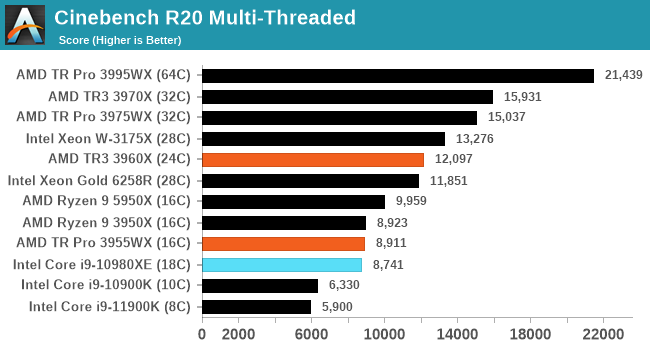
AVX512 Accelerated
2P: Intel Xeon Gold 6258R at $4100 (down from $4300)
1P: Intel Xeon W-3175X at $3075
I have added an AVX processor suggestion here for the simple fact that if a user is likely to encounter AVX acceleration, it’s going to be with software aimed at prosumers and high-end desktop users. Intel has been pushing its AVX512 support, even bringing it into its consumer laptop processors, in an effort to drive things like DLBoost to enhance AI throughput. One of the pain points I’ve had with Intel over the last couple of years is actually getting a list of AVX512 use cases: exact software examples where AVX512 is used. It often gets added for very specific things, like a certain filter in Photoshop, or a special edition of a benchmark, but ultimately those in the HPC space get the most from it. For those users, this suggestion is for you.
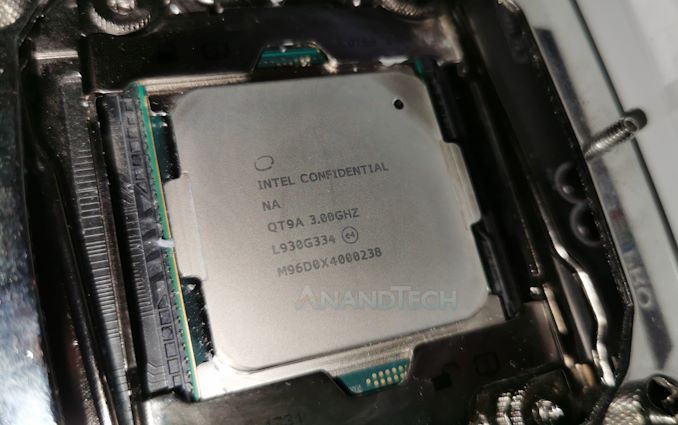
Our Core i9-10980XE review sample. It's a QS (Qualification Sample) chip,
which is meant to be as near as retail as possible.
The best high-end desktop off-the-shelf processor for AVX512 you can buy is the Core i9-10980XE, with 18-cores that all enable AVX512. If you need ECC, then the Xeon W-3275/3175X is going to be your best bet, but it will cost a bit more and a special Xeon W motherboard is needed. If cost is no object, then moving into a dual socket system with Xeon Scalable processors might be preferable, although take note that this introduces a non-uniform memory access (NUMA) environment, which would inhibit bulk data transfer if the software is not NUMA-aware. To be on the safe side usually single socket is preferred. The downside to going Intel here is finding a CPU for sale.

Some users might point to the Xeon Scalable side of the equation, for anyone needing more Enterprise level features. In the Cascade Lake-SP Refresh cycle, Intel launched the Xeon Gold 6258R, with a list price of $3950. This processor is essentially identical in every way to the top-of-the-line Xeon Platinum 8280 ($10009 list), except it only supports single and dual sockets. That’s a $6000-odd saving per-CPU if you’re not going above 2P. These Xeon Gold parts currently retail for $4020. The alternative is the Xeon W-3175X available for $3105, with slightly higher frequencies, but that can only do a single socket. The Xeon W-3275 is technically newer, but more expensive ($4449 1ku) and not technically a retail product-in-box product.
Ultimately, for the price of one Xeon Platinum 8280, users can get two Xeon Gold 6258Rs, get double the raw AVX performance, and still have change left over.
Memory Support:
AMD EPYC up to 4 TB per socket,
Intel Xeon with Optane DCPMM up to 4.5 TB/6TB per socket,
or Intel Core i9-10900X (or any Core i9-109xx series)
Some users are in it just for the memory support, either due to multiple VMs or high-memory use-case requirements. For these, sometimes the memory capacity is more important than the compute performance, as the software requires workspace in the terabytes – in this case doubling up to 128 GB of DRAM or more is always more beneficial than adding compute, as it reduces the pressure on moving data back and forth between DRAM and storage. Normally it is in this instance too that RDIMMs with ECC are recommended, just because as the memory capacity gets larger, the chance of an errant bit flip does scale with memory capacity. The price of the memory in this product category normally outweighs the CPU cost by an order of magnitude as well.
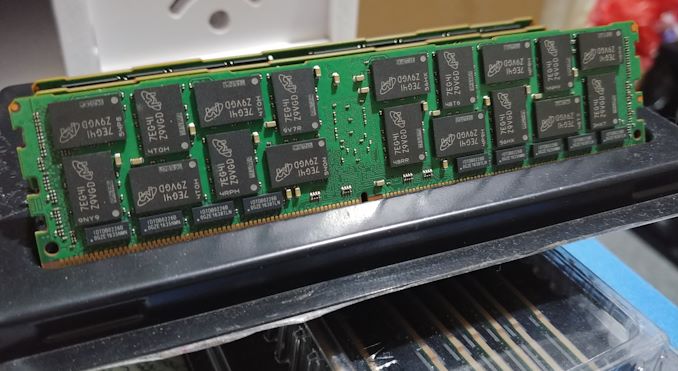
128 GB LRDIMM, original retail $4000+ (now $1200-ish)
In this instance, one choice is an EPYC, something like the 7232P will easily support 4 TB of LRDIMMs per socket out of the box. Mind you, if you’re buying *that* much memory, then going for the 64-core 7702P at $4722 isn’t that much of a leap.
The only way to get more memory than this with an x86 processor would be to look to Intel Xeon Scalable processors equipped with Optane DC Persistent Memory, allowing up to 4.5 TB per socket on Cascade Lake or 6 TB per socket on Ice Lake. In order to get that amount, you have to invest in one of the higher memory processors, which adds another $3k-$6k to the cost of the chip. The other factor here is that Optane DCPMM isn’t freely for sale through usual channels: it typically comes as part of an OEM system build, and as a result the user will end up with a support contact for a specific OEM. For bigger businesses and research communities, that should be suitable – check with your preferred OEM with what they have to offer.
I also want to put in a word here for Intel’s latest Cascade Lake-X processors. Normally, with four channels / eight memory slots and 32 GB of DRAM per slot, this would max out at 256 GB. But interestingly enough, when paired with an ASRock X299 motherboard (either the X299X Taichi, the X299 Steel Legend, or the X299 Creator), these motherboards can now support 128 GB RDIMMs, allowing for 1 TB of DRAM per single socket.
At this time ASRock is looking into also enabling LRDIMM support. This is a relatively new development, posted by one of ASRock’s engineers to his personal social media accounts, but the BIOSes required are now public, and for users invested in the Intel ecosystem this is well worth a look.
Cores for Cash:
AMD Threadripper 3960X (24c) at $1400
Intel Core i9-10980XE (18c) at $989
The biggest change in our guide this time around comes down to the cost per core metric. The previous recommendations were the Ryzen Threadripper 2000 family, however those products have been superseded and cost a lot more than they did at the end of 2020. So for anyone wanting the most cores for the least amount of $$$, then our pick is split into two: the Threadripper 3960X or the Core i9-10980XE.
We’ve spoken about both already in this guide, but it really comes down to budget. Both processors are on platforms no longer updated, however the TR3960X is newer, comes with more PCIe lanes, comes with PCIe 4.0 support, higher average frequency, more cache, and higher performance memory support. By contrast the Intel platform is very mature, and has AVX-512.
HEDT on a Budget:
AMD Threadripper 1900X $204 (down from $240)
If you want a HEDT system on a budget, the question to ask is if it has to be new or used. In a lot of professional circumstances, new is still preferred, and the processor to get on the ladder here is AMD’s Threadripper 1900X. The 8-core processor offers high capacity memory support, lots of PCIe lanes, and the low-end motherboards for Threadripper are now entering that low-to-mid range pricing. In a sale, the 1900X can be found for under $200 (users with more money might look for a cheap 1950X instead), which seems like a crazy low price for a high-end desktop processor. That being said, unless you need the PCIe lanes of the high-end desktop processor, looking for one of the newer 6-core Ryzen 5 5600X processors ($299 MSRP) might be more advised from a performance standpoint.
On The Horizon: Threadripper 5000 Series with Zen 3
We’re a year or more on from AMD and Intel’s previous HEDT launches, and neither company seem that keen to push more HEDT product onto the market.
Details on Intel’s future HEDT offerings are not clear in the slightest. We don’t know what Intel plans to launch in this space, or when. The company recently reduced the scope of its Cooper Lake Xeon platform to select customers only, launched its Ice Lake Xeon Scalable generation on 10nm, but nothing is there for HEDT/WS. Ice Lake Xeon is still not available in general availability, and while performance is a good generational improvement it still trails behind AMD’s current offerings, so we wonder if it will ever filter down. My prediction here is that Intel won’t look at this market again until its 7nm processors are in volume, at the earliest.
For AMD, Threadripper on Zen 3 (probably likely to be called Threadripper 5000) is expected to be coming this year – some were predicting early June due to the annual Computex trade show, however that has been and gone with no insights. As Zen 3 chiplets are straight drop-ins for Zen 2 chiplets, bring-up should go smoothly. But, those chiplets will initially be served in AMD’s EPYC processors first, because that is where the higher margins are. Demand for Zen 3 Enterprise is high, and with the current semiconductor demand for EPYC compared to the size of the Threadripper market, then next-gen Threadripper might have to wait a little bit longer.
We do however have the rest of Threadripper Pro 3900WX family in for testing, and we will be reviewing these on AnandTech shortly. The 3995WX 64-core has already been tested.
Recent Threadripper / EPYC CPU Reviews (AMD)
- AMD Ryzen Threadripper Pro 3995WX (64 core)
- AMD Ryzen Threadripper 3990X (64 core)
- AMD Ryzen Threadripper 3970X (32 core)
- AMD Ryzen Threadripper 3960X (24 core)
- AMD Ryzen 9 5950X (16 core Zen 3)
- AMD EPYC 7763 (64 core Zen 3)
- AMD EPYC 7F52 (16 core Zen 2, high frequency)
Recent HEDT / Xeon CPU Reviews (Intel)
- Intel Core i9-10980XE (18 core)
- Intel Core i9-9990XE (14 core, all-core 5.0 GHz)
- Intel Core i9-11900K (8 core Rocket Lake)
- Intel Core i9-10900K (10 core)
- Intel Core i9-9900KS (8 core, all-core 5.0 GHz)
- Intel Xeon Platinum 8380 (40 core Ice Lake, ECC)
- Intel Xeon Gold 6258R (28 core, ECC)
- Intel Xeon W-3175X (28 core unlocked, ECC)
Our benchmark database can be found at https://anandtech.com/bench


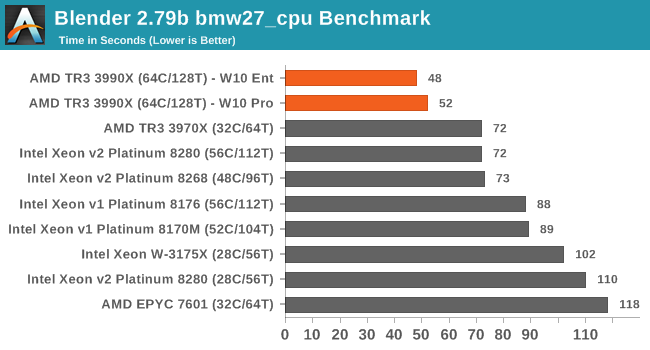
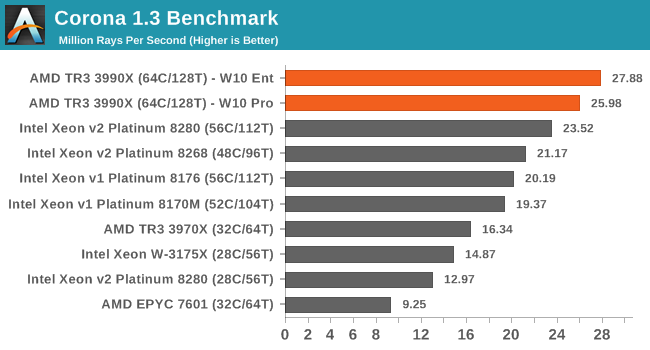
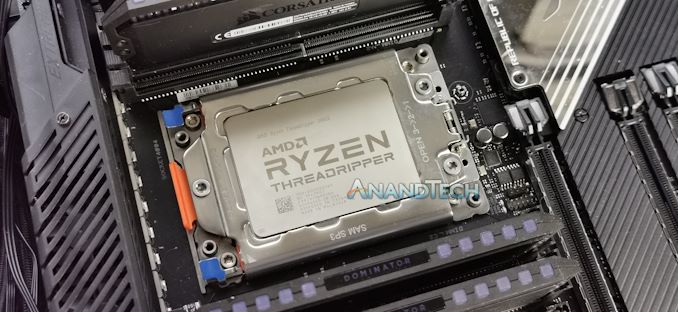
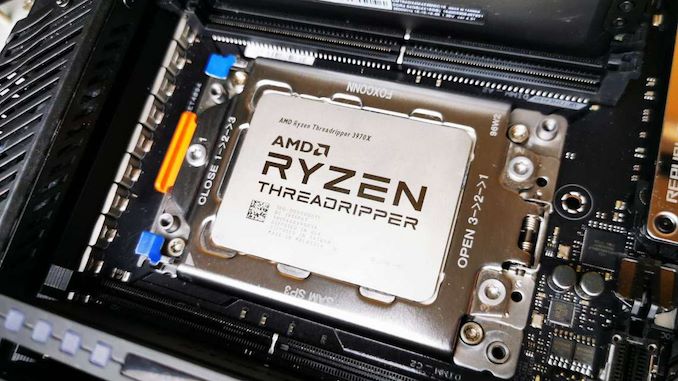
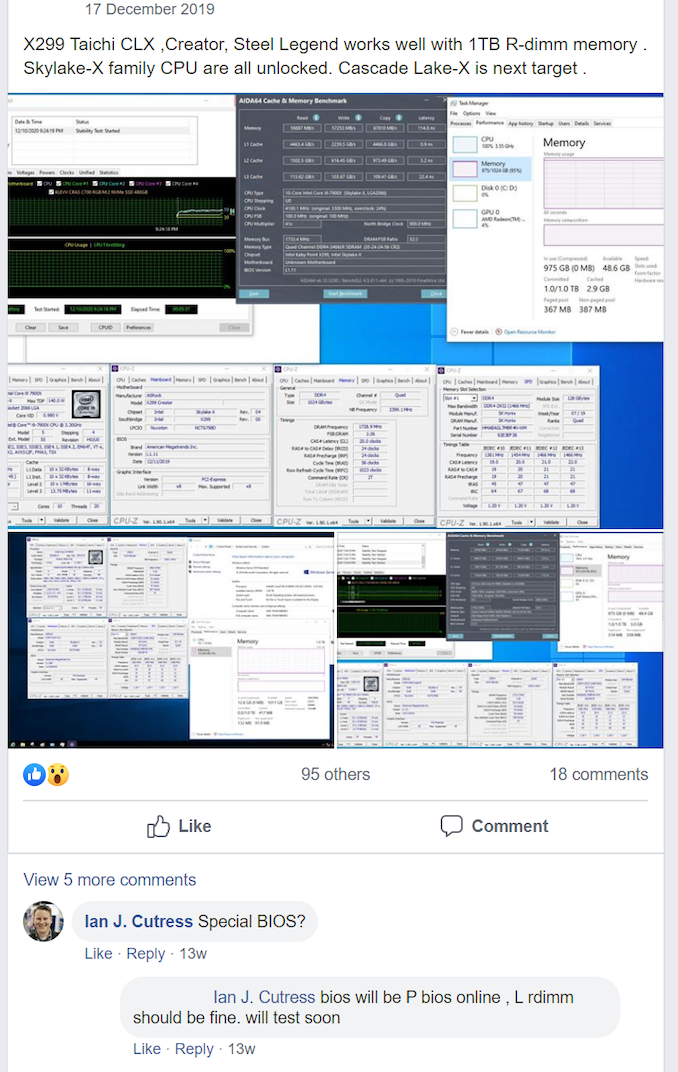









53 Comments
View All Comments
Atari2600 - Sunday, June 13, 2021 - link
I broadly agree. However it'd be good to see for context.$$$ limited purchases might demand a compromise. That decision may have been aided by seeing direct comparison of the 5950 to the HEDT CPUs. Yes, sacrifice on the platform side - but may be worth it for someone.
drajitshnew - Sunday, June 20, 2021 - link
I agree-- a note in the VFM/ budget constrained sections is warrantedtomatotree - Friday, June 11, 2021 - link
I think something is off in your AVX 512 chart: the 8C i9-11900K is shown beating the 64C Threadripper, and more than quadrupling the score of the previous gen 10C i9-10900K. If that score was real, the 11900 would be by far the best value on the chart, but I think it's far more likely something got mislabeled.Tomatotech - Friday, June 11, 2021 - link
Well spotted, brother.Slash3 - Saturday, June 12, 2021 - link
11th gen Rocket Lake supports native AVX512, while the previous 10900K parts do not.croc - Saturday, June 12, 2021 - link
For those waiting for an AMD Zen 3 Threadripper, my personal feeling is that AMD is not performing well at 7nm. EPYC processors may very well not scale up to the speeds required for a TR chip. And, they are having issues just filling their datacenter orders with the EPYC chips. I really wish someone would get pointy-headed with Dr. Lisa Su and ask these questions. Where is Anand Lal Shimpi when we need him? (Rhetorical question...)Smell This - Saturday, June 12, 2021 - link
Your username is an apt description of your posts ...
alexbirdie1 - Saturday, June 12, 2021 - link
In the graphics 3990x, 3970x and 3960x are described as TR3.Do you mean "Threadripper generation 3" or , if the socket type, should it be sTRX4 socket ?
BambiBoom - Saturday, June 12, 2021 - link
This “best” list is mysterious both as to whom it is addressed plus the choices. What percentage of the viewers of this site need, are using, or have a budget for $1,500 to $5,500 processors? “Best” is not so simple as to what has the highest benchmark numbers in two benchmarks that are both measuring relative to the number of cores. Processor performance is highly application dependent- single thread vs. cores, relative to clock speed and IPC, plus memory bandwidth, capacity, and speed.For example, compare a mid-range “Smart Money” choice of the Threadripper 3960X 24C @3.8 / 4.5 at $1,400. In Passmark Performance Test, the CPU mark is 55,010 and the Single thread Mark (STM) = 2,688 (506 tested). For comparison, consider the Ryzen 9 5950X (16C @ 3.4 /4.9GHz) $800 CPU= 46,144 STM= 3,500 (1,233 tested). Yes, the 3960X will run through Blender tile renders more quickly: 55,010 is 119% of 46,144, but the real-time tasks of making the 3D models will be noticeably faster due to the single-thread performance: the 5950X STM of 3,500 is 130% of the 3960X’s 2,688. When rendering videos or large batches of 3D CAD renderings or compiling, the system works on it’s own, the user walks away, but when hand-on working on 3D models, video or photo editing the highest single-thread is “best”. A much higher percentage of users will be looking at $800 processors than $1,400 “down from $1,600" processors. The inclusion of the Xeon W-3175X is simply silly: it’s 28C @ 3.1 / 3.8GHz / CPU= 36,360 / STM= 2,247 runs at 255W, costs $3,075 and there were only ever two motherboards made for it. Those are all signs of seriously dead product. The realm of AVX512 is uncertain enough and those interested might consider waiting to see how it and the associated hardware develops.
In m view, the article did not address memory bandwidth to a sufficient degree, as that is a critical difference in workstation applications and a significant reason to consider HEDT such as Threadripper Pro instead of “prosumer”. Consider benchmarking in the wide-range of WS specific applications to assist in revealing what is “best” (e.g., see Gamers Nexus).
Anyway, many of the choices in this list; the ones that are “down from $XXXX” are down from those prices as they are to be replaced in August by undoubtedly higher performing Zen 3 Threarippers. As well, as announced at Computex 2021, some Ryzen CPU’s are going to acquire a special 3X L3 cache chiplet (total on 5900X = 192MB instead of 64MB) averaging a 14% performance boost in Ryzen 5900X. Is it responsible to recommend as “best” components that are only two months from superior replacements as well in importantly improved products in other series?
Disappointing article but at least encourages discussion of workstation hardware.
Threska - Saturday, June 12, 2021 - link
Well if those new Ryzen CPUs are HEDT then I can see them being on this list. But of far more importance is availability. Currently looking at the TR Pro and they're somewhat available, but like the article says only three motherboards which really puts a crunch into the process since on most backorder*. Plus memory seems to be the current silent sticker shock at $1,000+*Most expensive and over-featured board at $999 and available.